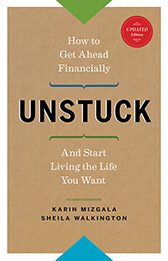 Every profession, sport and hobby has its own expressions, jargon, and acronyms that can leave those less familiar with them a little lost or confused. Helping our clients understand the language of money is one of the things our coaches take pride in, because we want to ensure that we are always talking with you, not at you.
Every profession, sport and hobby has its own expressions, jargon, and acronyms that can leave those less familiar with them a little lost or confused. Helping our clients understand the language of money is one of the things our coaches take pride in, because we want to ensure that we are always talking with you, not at you.
To that end, we’ve decided to start a glossary of terms we are often asked to clarify, and what better time to begin than November, which is Financial Literacy Month in Canada.
Here are four terms related to home ownership:
Term of a Mortgage vs. Amortization period
The mortgage term is the number of years the loan is valid. Mortgage terms range from six months to 10 years. Mortgage rates vary depending on the term, usually the lower the rate the shorter the term. At the end of the term, if the mortgage is not paid off, it will be renegotiated at a new rate for a new term.
The amortization period is the number of years it will take to pay off the entire mortgage. Usually the more years over which you spread the mortgage, the smaller the monthly payment will be, but, and it’s a big but, the longer you take to pay the mortgage the more you will pay in interest over the long term.
 For example: A $100.000 mortgage at 2.99% for a five year term amortized over 25 years would have monthly payments of $472.74. Over the five years of the term you would pay $13.822.10 in interest and if you were able to maintain that rate for the entire 25 years you would pay interest of $41,818.69.
For example: A $100.000 mortgage at 2.99% for a five year term amortized over 25 years would have monthly payments of $472.74. Over the five years of the term you would pay $13.822.10 in interest and if you were able to maintain that rate for the entire 25 years you would pay interest of $41,818.69.
If you took that same $100,000 mortgage and rate for the same five year term but chose to amortize over 15 years you would have monthly payments of $689.22. The initial five years your interest paid would drop to $12.826.18 and over the entire 15 year period of the mortgage the interest paid would drop to $24,058.21 a savings of $17,760.48 over the life of your mortgage.
Home Equity Loan vs. Home Equity Line of Credit (HELOC)
The equity you have in your home is the amount of money you would have after selling your home and paying off the mortgage. If your home is worth $300,000 and you have a mortgage of $200,000 you have $100,000 in equity.
With a home equity loan the bank lends you money based on the amount of equity you have in your home. This sort of loan is often referred to as a second mortgage because the repayment schedule is set up in the same way as your initial mortgage. With this loan you are granted a fixed amount and the repayment schedule is also fixed for the term of the loan.
A home equity line of credit (HELOC) is more fluid. The bank grants you a line of credit secured by the equity you have in your home. Much like a credit card, the amount available to you goes down as you use it. When you make a payment to the principal, (usually with a HELOC you are only required pay the monthly interest) the amount available goes up again. The amount available for use also goes up when you make your regular mortgage payments. This can be a useful way to borrow for renovations or for university tuition, but if you are undisciplined in repayment beyond monthly interest, or if you begin to use it for everyday expenses, it can be slippery slope into endless revolving debt, or what we call the “never-never plan.”
If you have a specific term you would like clarified or have money questions in general please feel free to ask in the comments section or visit our Ask a Money Coach Facebook Page. If you would like to contact a coach directly you can find contact info on our Coaches page.


